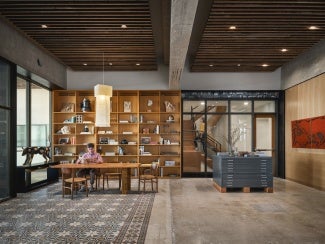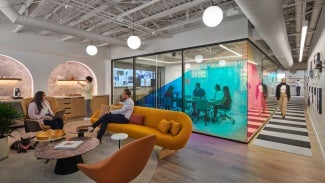
Return to office: How it started and how it's going
In the wake of the pandemic's remote work boom, firms continue to assess next steps for their practice.
Before the pandemic, architectural practice had been relatively staid. Few can attest to that better than Angela Watson, FAIA, CEO of the 150-year-old Boston-based firm Shepley Bulfinch. Any changes to how the firm designed and delivered projects occurred very slowly during its first 100 years and then slightly ticked up with the late 20th century’s technology wave, she says. Then the pandemic sent the rate of change skyrocketing. “We can’t go back to the way it was,” Watson believes.
Nearly four years after the WHO declared Covid-19 a pandemic, firms continue to assess next steps for their practice. Below, five design leaders share how their firms are moving forward: Leah Bayer, AIA, president of Architects Fora, a 12-person virtual firm; Dan Stine, AIA, director of design technology at Texas-based Lake|Flato Architects, which has 150 people primarily in two locations; Watson, who oversees 190 employees in six studios, including a virtual studio; Roxanne Malek, AIA, managing partner at SmithGroup, with 1,400 people across 19 locations; and Susan Klumpp Williams, AIA, co-CEO at HOK, with 1,700 people across 26 locations.
Work policies: Not one size fits all
For most design firms prior to 2020, in-office work hours and assigned seating were the norm. One exception was Bayer’s firm, which she founded as a virtual practice in 2018. At the end of 2020, she merged her practice with OJK Architecture + Planning, a bricks-and-mortar firm in the San Francisco Bay area. The resulting firm, Architects Fora, has moved forward as a virtual one. Employees live across the U.S., fulfilling their required 80 hours every two weeks whenever they work best, while being mindful of project needs.
Shepley Bulfinch has also retained a remote work policy. Employees can opt to work in a physical studio, though 25 employees are assigned to the virtual studio. Standard working hours loosely apply, and every Friday is a half day. “People are working whenever it works for their team and when it works for them,” Watson says. “The only important thing is that teams need to communicate and support each other.”
Lake|Flato employees are dividing their time equally between remote and in-person work, while HOK and SmithGroup are requiring three days in the office—Tuesdays, Wednesdays, and Thursdays for HOK, and Tuesdays, Thursdays, and an employee’s choice day at SmithGroup.
A recent internal survey showed an 87% employee approval rating on HOK’s hybrid work policy, according to Klumpp Williams. “Our employees love the flexibility of having three days in, two days out,” she says. “We are committed to continuing that in the near future.”
Malek openly acknowledges that not every employee was elated by SmithGroup’s hybrid policy, which goes into effect first for company shareholders in May and then for all staff in July. The firm’s human resources team is offering support documents and services around the transition and a network for employee concerns, she continues. “We’re committed to adjusting when we need to.”
Though many offices today are equipped with occupancy sensors and employees are checking out desk hoteling stations via apps, none of the leaders report taking attendance. “We are trusted professionals,” Malek says.
Building up employees
The firms operating on a hybrid schedule cited a desire for in-person education and mentorship as the driver. SmithGroup leaders had “started to see a little bit of erosion … of long-term, future growth of our staff,” Malek says. “We’re trying to be deliberate about the time we’re together to … make sure that our staff are getting the experience they need to understand the business and the industry.”
Firms that remain virtual are also leaning in on education and staff development. Each Architects FORA employee spends eight hours of their workweek researching a topic of their choosing, such as BIM management or human experience design, which they take turns presenting during twice-weekly staff meetings. “Our team members like having ownership over something that they’re passionate about, that they can share and feel like a leader in,” Bayer says. “But it’s not your typical path to leadership.”
Shepley Bulfinch holds virtual town halls every two weeks in addition to regular employee-led educational sessions and workshops. Watson says many designers do work side by side—they just do it via video conference.
Real estate movement
Physical office footprints have also changed since the pandemic, often in unexpected ways. Shepley Bulfinch downsized its 30,000-square-foot flagship Boston office to a 9,000-square-foot floorplate. The firm directed the savings in leases to supporting staff travel for projects and team get-togethers, Watson says. SmithGroup has also reduced several office footprints, while renovating others to have fewer workstations and to support agile seating and more communal spaces.
During the pandemic, Lake|Flato thoroughly renovated its three-story, 15,000-square-foot headquarters in San Antonio. In anticipation of a hybrid work environment post-pandemic, Stine says, the firm provided only 82 desks for its 120 local employees. It transformed an adjoining one-story parking garage into an open-air courtyard that hosts farmers markets and outdoor collaboration areas.
HOK added three new locations last year, Klumpp Williams says. As existing leases have come up for renewal, the firm has been renovating or relocating to larger offices and adding features, like sound attenuation, that support different ways of working. “We are trying to implement spaces that we are designing for our clients,” she says, alluding to the fact that architects often overlook their own office design.

Technology reliance in new ways
Though many design firms were experimenting with digital tools before 2020, the pandemic demanded adoption. Architects FORA uses Google Workspace for its business tools and Slack for messaging. Shepley Bulfinch, SmithGroup, and HOK have landed on Microsoft Teams, while Lake|Flato has gone all in with Zoom, Zoom Rooms, and Zoom Whiteboard. Enscape, Miro, Bluebeam, and Conceptboard remain popular as collaboration and markup tools.
Though sketching on screens, whether it be a tablet or a smartboard, has become more natural for designers, many virtual pin-ups have returned to literal pin-ups. However, personal desktop computers have remained solidly in the pre-pandemic era. Employees, equipped with a laptop or simply a tablet, now remote into workhorse computers or head into the cloud for intensive-computing tasks, such as Revit and image rendering.
Lake|Flato employees only carry a tablet, each configured to remote via VMware Horizon into their personal desktop computers, which are permanently housed inside the firm’s server room. “They’re only downloading a video feed from that remote computer,” Stine says, so the tablets and Wi-Fi are not bogged down. Employees use Flowscape to check out desks, which provide a keyboard, mouse, display monitors, and a USB-C cable for the tablet. “You plug that in and it basically runs your entire computer,” Stine says. “It’s critical to have a technology layer that makes it seamless to work remote or in the office and is also super consistent. Every single conference room is exactly the same.”
Technology has become so second nature that many leaders have realized returning to in-person interactions will take time. “You’ll see four different people on a Teams call sitting in the same area,” Klumpp Williams says. “Go to a conference room, go thrive, be with others!”
Client satisfaction
Clients and consultants also adapted during the pandemic. Many are content with fewer in-person meetings, saving on time, cost, and carbon emissions due to travel. “Some of our higher ed clients appreciate being virtual because they can bring in more stakeholders and have a more inclusive environment,” Malek says.
In-person meetings tend to be reserved for major project milestones and interviews. “You tend to build a rapport better when you’re in the same room,” Klumpp Williams says.
Flexibility and service are key, Watson says: “If there’s a client who really needs to be in-person, that’s how we compose the team.”
Architects FORA’s in-person community engagement sessions have become so successful that other design firms have begun outsourcing to the virtual firm, leading Bayer and her partners to start a spin-off practice, Engage FORA.
Impact on talent
The increased flexibility of architecture firms has been a boon for employee retention and recruitment. “The ability to find people all over the country gives us much more access to diversity, in every sense of the meaning,” Watson says.
Since the pandemic, many companies have also expanded their benefits, such as increasing PTO. Along with HOK’s hybrid work week, Klumpp Williams says, “the enhanced benefits are also a huge recruitment help.”
An employee has yet to voluntarily leave Studio FORA, Bayer says. Her most recent job posting received 300 applications within 24 hours. “We needed one person and ended up hiring three people because [the applicants were] so great,” she says. “People want something really different, both in the way we practice and in how we look at the role of the architect.”
Seasons of change
The pandemic was a wake-up call to the tenuous nature of life and work. Architecture firms that continually evaluate their operations, tools, and employee needs will be better equipped for the unexpected. “We don’t have to have everything solved on day one,” Malek says. “We’re excited to learn and adjust, and that’s worked well for us, especially over the last five years.”
Every firm needs to become agile, Watson believes. “The speed at which we have to keep up is going to increase,” she says. “The more we can do to get ourselves out of, ‘We always do it this way,’ the more ready we will be successful in a new world.”
